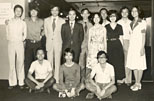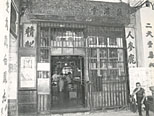Special Article
A Review of the Development of the Hong Kong Museum of History in the Past 30 Years (2): Thirty Years Ago......
Mr Gerard C. C. Tsang
Assistant Director (Heritage and Museums), LCSD
2005
|
Being the only graduate in Chinese Art and Archaeology from the University of Hong Kong in 1971, I had to work for 4 years as an Executive Officer (Accounts) until I had an opportunity to join the museum service. I can still vividly recall reporting to C.H. Ho, Curator (Museum of History) in a barrack block in Kowloon Park by late June 1975 as an Assistant Curator (Archaeology). It was within weeks from the opening of the Hong Kong Museum of History in the rented commercial premises at Star House, Tsim Sha Tsui.
|
| The small planning team was working under extreme pressure to open the new museum in time. I was fortunate to have the guidance of Robert Lam, Assistant Curator (Local History) and Alex Yip in archaeology. C.H. Ho is a fine gentleman and a kind teacher. Robert is a piece of history himself whose rich personal encounters with local villagers in ethnographical research have won him open arms wherever he ventures. Alex is a man of principles and a scholar in archaeology.
|
| As a late-comer to the team, I was eager to join field excursions, whether they may be an archaeological excavation on Sha Chou island or ethnographical collection trips to remote villages. I can still remember the scorching heat of the overhead summer sun while digging in a test pit of more than 2m deep on Sha Chou where the breeze only passed over the ground surface. I had the rare opportunity to handle excavated artifacts from local sites as well as the famous Fr. Finn archaeological collection from Lamma Island and the Fr. Maglioni collection from Eastern Guangdong. In these direct contacts with the ingenious creations of our distant ancesters, I have cultivated my respect for cultural relics for life.
|
| I can still recall collecting used farming implements and old village furniture at Tin Fu Tsai village in the remote hills of the Tai Lam Chung area where there had been reports of a python swallowing goats. When Robert and I, together with other staff were carrying these field collection items up a slope, we were caught up by a summer storm. We were soaking wet and could not help laughing because we looked absurd, like a funeral procession in the rain. We had anticipated rain in view of the approaching black clouds but the old villager advised that we had better collect the bridal chair immediately or his wife would not bear to part with it at her return. So, we risked the storm.
|
| I can still recall joining the inaugural sail of a new fishing junk in Aberdeen to Po Toi Island where fresh fish were caught and tasted on board. I was fascinated with the fishermen's customs, beliefs and their hardship of life at sea.
|
|
These field trips have left lasting impressions and have inspired me to write full length plays on local fishermen - "Ebb" and local farmers - "The Evacuation Order" in mid-1980s. The latter was revised by me in 2004 for a full length dance performance by the Hong Kong Dance Company.
I can still remember calling on the famous herbal shop - Shing Tsai Tong while it was still in operation in the Central and Western District in 1975. When the shop ceased to operate, we purchased it, took it down piece by piece and eventually re-install it in its full glory in "The Hong Kong Story" permanent exhibition staged in Kowloon Park in 1991.
|
| I only served in the Museum of History till mid 1976 when I took up the Assistant Curator in Chinese Art and Antiquities at the Museum of Art. The short period of my work at the Museum of History has built up a solid foundation for my life long museum career and has won me lasting friendship till this day.
|

Mr Gerard Tsang (third from left, back row) and other Museum staff in the early years.

Shing Tsai Tong in the early 1980s, which now becomes part of the Museum's permanent exhibition settings.




